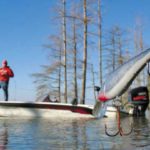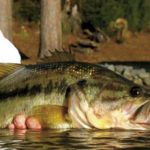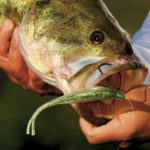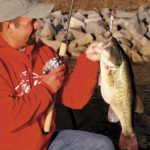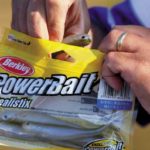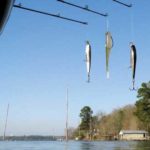
Think these lures catch only small fish? Think again. Whip out your jerkbaits this month, and prepare to be surprised.
Had it not been for missing roe estimated to be 1 1/2 to 1 3/4 pounds, Wisconsin resident Ed Stellner would have landed a new state-record largemouth bass back in February of 2000.
Stellner, a tournament angler who was on D’Arbonne for some fun fishing with his buddy Ross Cagle, said the two idled toward the back of Bear Creek below the Highway 33 Bridge. As soon as they rounded a bend, Stellner saw what he was looking for.
“There was a point on the left side as we motored into the creek that looked like it had some deeper water off it,” he said. “It had a few cypress trees, and the water was stained but not muddy. Fish could see what they were eating. I told Ross that this looked like good Rogue water.”
Explaining that he wasn’t in Wisconsin anymore, Cagle joked with his fishing partner about not being able to catch a bass on a Rogue around North Louisiana. Not sure if Cagle was serious or not, Stellner began casting his black/orange jerkbait, one that had produced for him all over the country.
Stellner almost immediately began landing quality bass on the Rogue. He had wrapped some soldering wire around the treble hook shanks so the bait would get deep and suspend. After twitching it down to about 6 feet, he would let the jerkbait hang by the tree for a moment.
“We were right beside this tree, and I didn’t have a lot of line out,” Stellner recalled. “I got bit, and saw this big fish come to the surface. She got her mouth out of the water, and I didn’t want to let her dive back down because of the trees.”
Cagle put down his rod to help his friend land the fish, but he encountered a slight problem when he reached for the fish.
“Ross reached over and couldn’t pull the fish in with one hand because he has a bad back,” Stellner added. “He kept telling me to give it some slack, but I wouldn’t. He told me that we had a good one, but he couldn’t get it in.”
Realizing that something had to give, Stellner gave the fish some slack and put down his rod. He grabbed Cagle by the collar and the belt so he could let go of the side of the boat and grab the fish with both hands. Stellner yanked both into the boat, and the fight was over.
The fish weighed in at 15.31 pounds, just shy of the 15.97 state record. Stellner eventually learned after donating the fish to the LDWF that the fish had spawned just hours before it was caught.
Within the excitement of this particular fish story, it may have been lost that the lure Stellner was throwing was a jerkbait — not the most popular big bass lure. Move over to Mississippi, and the state record wasn’t almost caught on a jerkbait, it was caught on a jerkbait. Who knew jerkbaits were such heavy hitters?
Chris Slopak knows. Slopak, who recently moved from Arkansas to Haughton in Northwest Louisiana, has fished the various levels of the FLW Outdoors tournaments from the Wal-Mart BFLs to the FLW Tour, and he has relied heavily on jerkbaits for much of his success. His best day as a pro was a 27-pound, 9-ounce limit caught at Lake Amistad in Texas during a Stren Series tournament in 2006.
“I was fishing on the edge of a river channel sitting in 18 feet of water and throwing into 40 feet,” Slopak recalled. “I was hitting the edges of the trees and hydrilla down around 9 feet. The fish were lethargic, so I made sure to pause the jerkbait for up to 4 seconds at a time.”
Another angler who knows is Jarrod Bishop, promotions manager for the Shreveport Bass Pro Shops. Bishop, a transplant to Louisiana from Ohio, considers jerkbaits his favorite way of fishing for bass.
“I grew up throwing those old gold Rapalas with the black back and the silver one with black back,” Bishop said. “When I was younger, I would go down to the creek beside our house and watch bass go after creek chubs and other baitfish.”
Seeing these bass attack the natural-looking slender baitfish made an impression on Bishop that one of the best ways to catch bass had to be by throwing something that looked almost exactly like what the bass were eating in that creek.
While both anglers recognize that jerkbaits are productive lures that can fool a lot of bass, they also both agree it’s important for anglers to know why, when and where to employ the distinctly different types of jerkbaits — hard and soft.
Hard jerkbaits are typically crankbait-style lures that are longer and thinner and feature a smaller diving lip. Hard jerkbaits feature two or three treble hooks, depending on the length of the lure, which can run from 3 to 4 1/2 inches long.
Baits that fall into the hard jerkbait category are the Smithwick Rattlin’ Rogue, Bomber Long A, Berkley Frenzy Firestick, Bass Pro Shops XPS Nitro Minnow, Team Diawa Minnow and H20 Xpress Jerk Shad.
Soft jerkbaits are more like a plastic worm than a jerkbait. They are rigged onto a wide-gap hook in what’s been called “Texposed.” Texposed means rigging the bait like a Texas-rigged worm.
However, the hook is pushed through the body of the lure at a 90-degree angle so that the point lies tightly to the back of the bait. This keeps the soft jerkbait virtually weedless and, therefore, the better options for heavy cover.
Soft jerkbaits include lures like the original Slug-Go, Zoom Super Fluke, Mann’s Hardnose Jerkbait, Bass Pro Shops Super Shadee Shad, Culprit Jerk Worm, Berkley Gulp! Jerk Shad and the PowerBait Realistix Jerkshad.
Since an angler can only fish one lure at a time, the jerkbait has to fight its way through sections of jigs, spinnerbaits, crankbaits and buzz baits just to get noticed. Why should an angler pick the jerkbait over these other obviously proven lures? The simple answer is that these baits look like small fish, and big bass love to eat small fish.
“A Rogue is a bait that you can get down to where the fish are suspended, something they do frequently during the post spawn, and leave it in front of them a while,” said Stellner. “When you twitch it every now and then, it looks much like a wounded or lethargic shad that’s trying to gain its composure. Couple that with the flash that many of these lures throw out, especially the hard ones, and you’ve got a bait that is hard to beat.”
Soft jerkbaits have just as much going for them with the added bonus that they are single-hook lures that can be fished in the heaviest of cover. Landing percentages are also higher on soft jerkbaits once a fish is hooked well because the bigger, single hook is harder for bass to gain leverage and throw.
If you need a little extra incentive as to why you should be throwing a jerkbait this spring, Slopak wants you to consider just how many professional anglers rely on them.
“I don’t think people realize how much a jerkbait plays a role in tournament fishing,” he said. “It’s a bait that gets fished a lot, but it’s one that not very many anglers talk about. They put a lot of fish in the boat for tournament anglers over the course of a tournament season.”
Why Louisiana bass anglers should tie on jerkbaits is pretty simple — these realistic lures catch fish.
When and where to fish them is a little more nuanced. Since bass eat baitfish all year long, jerkbaits will work all year long. However, there are times when jerkbaits separate themselves from the rest.
While many anglers believe jerkbaits to primarily be pre- and post-spawn lures, the fact that Stellner’s giant fish was a post-spawn fish, even though it was caught in February, should be all the proof anglers need to fish them during this tough bite.
“I use a jerkbait year round,” said Slopak. “But I got a little extra proof that they work well during the post-spawn during a Stren Series event at Sam Rayburn one year. I qualified for the FLW Tour by staying in sight of the dam and throwing a hard jerkbait three days in a row for post-spawn fish.”
Slopak says from his perspective, female bass that are finished spawning are worn out, and they like to move out to flats between the spawning flats and the first major drop-off. In lots of Louisiana lakes, this major flat is typically around 3 to 8 feet — the perfect zone for working hard or soft jerkbaits.
“Take the Berkley Frenzy Firestick, for example,” said Slopak. “I like to get out on these flats and work that bait around any depressions, ditches or troughs. These post-spawn fish like to be near that deeper escape route. I can work the Firestick down to about 2 feet, and draw up suspended fish that react to it more so than eating it because they’re hungry.”
Even though April is primarily a post-spawn month in Louisiana, there are still some stragglers that come in late to spawn, and according to Stellner, a Rogue is a great way to bed fish for bass spawning on the sides of cypress trees.
“I like to wrap soldering wire around the hook shanks so the bait gets down deeper and stays there,” said Stellner. “Then I throw past a cypress tree and work it down so the lure is about 5 or 6 feet down on the tree when it gets beside it.
“Big bass will spawn deeper on these trees, and getting a Rogue down there and stopping it is just like bed fishing for a spawning fish in shallow water. You can make that lure just hang in her face until she can’t stand it anymore.”
While the post-spawn isn’t Bishop’s favorite time to fish jerkbaits, he does rely on the Bass Pro Shops Super Shadee Shad when he finds himself fishing around fry balls this time of year.
“You can catch a lot of males doing that,” he said. “The males tend to stick close by the fry to run off anything that looks like it might eat the small fish. A jerkbait swimming near the fry, especially a bream colored one, can trigger those males to bite.”
The one condition that forces anglers to rely more on soft jerkbaits than hard ones is heavy cover — namely thick vegetation. Bass love to get in the thickest sections of a grass flat this time of year, and there’s no better way to go in and root them out than with a soft jerkbait.
Slopak rigs a Berkley Gulp! Jerk Shad with braided line, and casts it towards points, indentations and holes in the grass. As his lure reaches the edges of these three places, he kills the action and lets it fall straight down into the likely strike zone.
“Even if you aren’t fishing a jerkbait around grass, keep one rigged up as a follow-up bait,” he advised. “Say you’re fishing a topwater frog or buzz bait. If you miss a fish on top, you can immediately pick up the soft jerkbait and throw it to the exact spot where the fish bit. More often than not, he’s still down there wondering where his meal went.”
While hard and soft jerkbaits work well right out of their packaging, Slopak suggested that no one jerkbait is perfect all the time. In fact, he has a few tricks for making hard and soft jerkbaits even better than they already are.
“The first is to remove the rear treble hook on a hard jerkbait and replace it with one dressed with feathers,” he said. “That’s a good teaser. When you stop it, those feathers will open and breathe. I think they eat it better that way.”
For soft jerkbaits, Slopak recommended dying just the tops of the tail either chartreuse or red. Chartreuse is productive during the post-spawn when bass begin to feed on bream. And while many soft jerkbaits can be purchased with chartreuse tails, he believes that these can be too chartreuse.
“You can also add what we call a stinger hook to a soft jerkbait for short-striking fish,” Slopak said. “Run the hook through the nose of the lure, and thread on a No. 4 treble hook so that one of the hooks is pointed directly at the lure. Stick that little hook into the body of the soft jerkbait. It’s not as weedless this way, but in open water, it can pay off.”
As almost journeyman lures, jerkbaits might not be the sexiest baits in your tackle box, and you might not come within a pound of setting a new state record by fishing one, but they will catch bass this month — lots of them. It’s time they get top billing with all the other heavy hitters.
